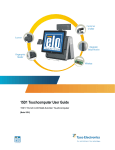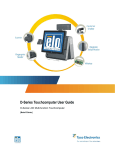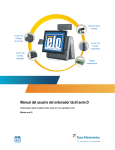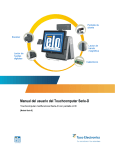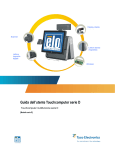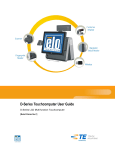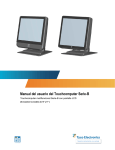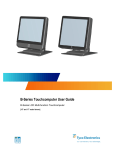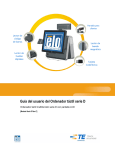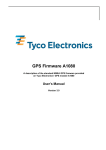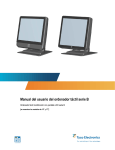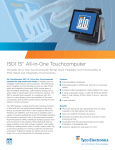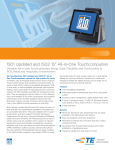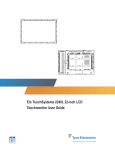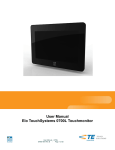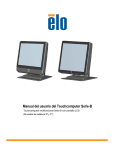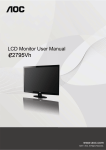Download D-Series Touchcomputer User Guide
Transcript
D-Series Touchcomputer User Guide D-Series LCD Multi-function Touchcomputer [Model D-Series] Elo TouchSystems D-Series Touchcomputer User Guide Multi-function Touchcomputer Revision B P/N E674343 Elo TouchSystems 1-800-ELOTOUCH (1-800-356-8682) www.elotouch.com Copyright © 2009 Tyco Electronics. All Rights Reserved. No part of this publication may be reproduced, transmitted, transcribed, stored in a retrieval system, or translated into any language or computer language, in any form or by any means, including, but not limited to, electronic, magnetic, optical, chemical, manual, or otherwise without prior written permission of Elo TouchSystems. Disclaimer The information in this document is subject to change without notice. Elo TouchSystems makes no representations or warranties with respect to the contents hereof, and specifically disclaims any implied warranties of merchantability or fitness for a particular purpose. References in this publication to Elo TouchSystems products or services do not imply that Elo TouchSystems intends to make them available in all countries in which Elo TouchSystems operates. Elo TouchSystems reserves the right to revise this publication and to make changes from time to time in the content hereof without obligation of Elo TouchSystems to notify any person of such revisions or changes. Trademark Acknowledgments Elo TouchSystems, IntelliTouch, SecureTouch, AccuTouch, MonitorMouse, TE logo, and Tyco Electronics are trademarks. Other product names mentioned herein may be trademarks or registered trademarks of their respective companies. Tyco Electronics claims no interest in trademarks other than its own. 15D1 TOUCHCOMPUTER USER GUIDE iii Table of Contents Chapter 1: Setup..................................................................................... 1 Unpacking Your Touchcomputer ....................................................................................................1 Adjusting the Display ......................................................................................................................2 Setting Up the Operating System.....................................................................................................2 Testing Peripherals...........................................................................................................................5 Calibrating the Touchscreen ............................................................................................................5 Securing the Base.............................................................................................................................7 Advertising Brackets........................................................................................................................7 Chapter 2: Operation.............................................................................. 9 On-Screen Display (OSD) .............................................................................................................10 LED Functionality .........................................................................................................................11 Using the Input/Output Panel.........................................................................................................13 Chapter 3: Options and Upgrades....................................................... 16 Adding Optional Peripherals..........................................................................................................16 Magnetic Stripe Reader (MSR) .....................................................................................................17 Customer Display...........................................................................................................................19 Fingerprint Reader (FPR) ..............................................................................................................21 Barcode Scanner ............................................................................................................................22 Third-Party Peripherals..................................................................................................................27 Chapter 4: Safety and Maintenance .................................................... 29 Safety .............................................................................................................................................29 Care and Handling .........................................................................................................................30 Recovering the Operating System .................................................................................................31 Chapter 5: Technical Specifications ................................................... 32 Touchcomputer Specifications.......................................................................................................32 Connector Specifications ...............................................................................................................36 Cash Drawer Port Specifications ...................................................................................................37 Display Screen Specifications........................................................................................................38 Environmental Specifications ........................................................................................................39 15D1 TOUCHCOMPUTER USER GUIDE iv Chapter 6: Technical Support.............................................................. 41 Technical Assistance......................................................................................................................41 Regulatory Information ..........................................................................43 Warranty ..................................................................................................46 Index ........................................................................................................48 15D1 TOUCHCOMPUTER USER GUIDE v C H A P T E R 1 SETUP This chapter discusses how to set up and test your touchcomputer. For information on peripheral options, refer to Chapter 3, “Options and Upgrades.” Unpacking Your Touchcomputer Check that the following items are present and in good condition: Power cable US/Canada Power cable Europe Touchcomputer Recovery DVD and Quick Install Guide Advertising brackets Optional security screw 15D1 TOUCHCOMPUTER USER GUIDE 1 Adjusting the Display The display screen can be adjusted from 0 to 60 degrees, as shown below. CAUTION: To protect the LCD, be sure to hold the base when adjusting the display, and take care to not touch the screen. Setting Up the Operating System The initial setup of the operating system takes approximately 5-10 minutes. Additional time might be needed for different touchcomputer hardware configurations and connected devices. To set up the Windows OS for the touchcomputer, turn on the touchcomputer by pressing the power button, and then follow the instructions on the screen. Selecting the Language Windows uses English as the default language in menus and dialog boxes. You can change this language to suit your preferences. 15D1 TOUCHCOMPUTER USER GUIDE 2 1. Click Customize. The Regional and Language Options window appears. Select the Languages tab. 2. If required, check the boxes for “Install files for complex script and right-to-left languages” and “Install files for East Asian languages.” 3. Select the Regional Options tab. 4. Select your preferred language from the drop-down list in the Standards and formats pane. 15D1 TOUCHCOMPUTER USER GUIDE 3 5. Click Apply. 6. Select your location from the drop-down list in the Locations pane. 7. Click OK. 15D1 TOUCHCOMPUTER USER GUIDE 4 Selecting the Time Zone When the following window appears, you can change the time zone, date, and time of the touchcomputer. After making any changes, click Next to finish. Windows Setup completes the installation of the touchcomputer. Testing Peripherals The touchcomputer can be configured with several different optional peripherals, such as a MSR or cash drawer. To test an optional peripheral that is installed on the touchcomputer, refer to the instructions in Chapter 3, “Options and Upgrades.” NOTE: Testing icons are located on the desktop. Testing a particular peripheral can only be done after the device is properly installed. Calibrating the Touchscreen The touchscreen is pre-calibrated for accurate touch response. If for any reason the touchscreen needs to be recalibrated, right-click the Elo icon in the Taskbar and then click “Properties.” The following window opens. NOTE: Calibration is not applicable to APR models. 15D1 TOUCHCOMPUTER USER GUIDE 5 Click the Align button. This launches the calibration program. The window shown below opens. Follow the instructions to calibrate the touchscreen. 15D1 TOUCHCOMPUTER USER GUIDE 6 Securing the Base There are two mounting options for the D-Series touchcomputer. In both cases, the base must be mounted on a horizontal surface. • Option 1: Secure from below. Use the four pretapped holes to secure the touchcomputer from below the mounting surface. The holes are designed to work with ISO metric m6 screws. These screws are not contained in the package, but should be readily available at any hardware store. • Option 2: Secure from top. Use the two through holes to secure the base to the surface. NOTE: Mounting screws are not provided with the shipment. Refer to the figure below for the location of the holes. All dimensions are in millimeters. Option 2 Through holes Option 1 Pretapped holes Advertising Brackets Advertising brackets are provided to allow the user to display paper ads on the back of the D-Series touchcomputer. These brackets are included separately in the accessory box. The maximum size of the advertising material is 220mm X 320mm (8.6” X 12.6”). 15D1 TOUCHCOMPUTER USER GUIDE 7 To install these brackets, simply push them onto the sides of the back door of the D-Series touchcomputer, as shown in the figure below. Then insert the advertising material as shown below. 15D1 TOUCHCOMPUTER USER GUIDE 8 C H A P T E R 2 OPERATION This chapter describes how to control the On-Screen Display (OSD), power buttons, and I/O panel. All adjustments made to the OSD and power controls are automatically saved. User settings remain unchanged after powering off/on or in the case of a power failure. 34 5 6 7 8 9 1 2 1. HDD status LED 2. Computer power LED 3. Head power LED 4. Touch power LED 5. Menu button 6. Left button 7. Right button 8. Select button 9. Power ON/OFF button 15D1 TOUCHCOMPUTER USER GUIDE 9 On-Screen Display (OSD) OSD Menu 1. To display the OSD Menu, press the Menu button. Press the RIGHT button or LEFT button to toggle and the SELECT button to select from the different OSD sub-menus and functions. 2. When the function you want to change is shown, press the SELECT button. 3. To adjust the value of the function: 4. Pressing the RIGHT button increases the value of the selected OSD control option. 5. Pressing the LEFT button decreases the value of the selected OSD control option. The OSD provides the following settings. Feature Description Auto adjust Automatically adjusts system clock. Brightness Adjust brightness and contrast. Image setting • Brightness: Adjusts the backlight of the monitor. • Contrast: Adjusts the maximum luminance level of the monitor. Adjusts H position, V position, clock, and phase. • H position: Moves the screen horizontally right and left (1 pixel pitch increment). • V position: Moves the screen vertically up and down (1 line increment). • Clock: Adjusts the ratio of dividing frequency of the dot clock. • Phase: Adjusts the phase of the dot clock. Color Sets color temperature (9300K, 7500K, 6500K, 5500K, or User Preset). OSD Adjusts H position, V position, and OSD timeout. • H position: Adjusts the OSD menu screen position left or right. • V position: Adjusts the OSD menu screen position up or down. • Timeout: Adjusts the amount of time that the OSD menu is displayed. 15D1 TOUCHCOMPUTER USER GUIDE 10 Feature Description Language Changes language to English, French, Italian, German, Spanish, Japanese, Simplified Chinese, or Traditional Chinese. Recall Sets color recall and recall defaults. Restores original factory settings. Miscellaneous Adjusts sharpness, enables/disables DDCCI function. • Exit Sharpness: Adjusts sharpness of video. Exits the OSD. OSD and Power Button Control The OSD menu and power button are enabled by default. To enable or disable the OSD function: 1. Simultaneously press Menu/Exit and the Left (<-) key for two seconds. A window appears displaying OSD ENABLE or OSD DISABLE. 2. When the OSD is disabled, the OSD menu is not visible. To enable or disable the power button (PWR) lock function: 1. Simultaneously press Menu/Exit and the Right (->) key for two seconds. A window appears displaying PWR ENABLE or PWR DISABLE. 2. When the power button lock feature is activated, the power button is disabled. LED Functionality Base Power Status LED The D-Series base has two LEDs that indicate the power status and hard drive status. See the figure on page 9, item 1 for the location of this LED. The light can be green, flashing green, red, or off. The table below shows LED state and corresponding color. LED Color to Observer State Off No input power — Off mode Red Input power present, power switch off — Off mode Flashes green Input power present — Sleep mode Green Input power present — On mode 15D1 TOUCHCOMPUTER USER GUIDE 11 Head Power Status LED The head power status is indicated by a different LED, which is located at the lower edge of the head (#3 in figure on page 9). LED Color to Observer State Off No input power to head — Off mode Red Input power present, power switch off — Off mode Amber Input power present — Sleep mode Green Input power present — On mode Touch Power Status LED The touch power status is indicated by a separate LED located at the lower edge of the head and to the right of the Head Power Status LED (#4 in figure on page 9). This feature is available for AT and APR 7010. LED Color to Observer State Off No input power — Off mode Red Input power present, power switch off — Off mode Amber Input power present — Sleep mode Green Input power present — On mode HDD Activity LED Hard disk drive activity is indicated by a flashing LED on the base, just under the computer power LED (#2 in the figure on page 9). Reading from and writing to the disk causes the LED to flash. LED Color to Observer State Off No activity Flashes green Activity 15D1 TOUCHCOMPUTER USER GUIDE 12 Using the Input/Output Panel To access the input/output (I/O) ports, open the cable cover door on the left side of the unit, as shown below. Optional security screw Opening for cables The touchcomputer provides a number of input and output interfaces for connecting a wide variety of compliant devices as shown in the following figure. 15D1 TOUCHCOMPUTER USER GUIDE 13 1 8 9 2 3 4 10 11 12 13 5 14 6 7 15 15D1 TOUCHCOMPUTER USER GUIDE 14 Number Port Description 1 Audio Audio in (left), out (center), mic (right) • Audio In • Audio Out: One 3.5mm stereo audio output jack for connecting headphones or external powered speakers • Microphone Input: One 3.5mm microphone input jack for connecting an external microphone 2 Ethernet One RJ45 Ethernet port providing LAN capabilities 3, 8, 9 USB Seven USB 2.0 type A ports 4 VGA One D-SUB VGA output port for connecting the display head 5 Parallel Standard 25-pin connector port 6 Serial Three standard serial ports 7 PS/2 universal Mouse (left) and keyboard (right) 8 Customer display Customer display / USB 2.0; the max loading on this port is 5VDC @ 1.5A 10 Printer power One 24V DC printer power port 11 Compact flash Standard CF port 12 Speaker power Power switch for internal speakers 13 Cash drawer RJ11, 6 position (12V/24V default) 14 Powered serial Two powered serial ports, 5V default/12V 15 Main power AC power NOTE: The customer display, fingerprint reader, and barcode scanner are designed to connect to the USB 2.0 ports on the I/O panel. If all three peripherals were connected, there would be four USB 2.0 ports remaining. 15D1 TOUCHCOMPUTER USER GUIDE 15 C H A P T E R 3 OPTIONS AND UPGRADES Adding Optional Peripherals When adding a peripheral, complete installation and setup instructions are provided with the field-installable kits. The following peripherals are available in field-installable kits: • Magnetic stripe reader (MSR) • Customer display • Fingerprint reader (FPR) • Barcode scanner (1-D or omni-directional/2-D) • Wireless mini-PCI kit • Hard disk drive • Printer power cable NOTE: The peripherals described are all options that are purchased separately. NOTE: Testing software is available in the folder 15D1 Test Applications, which is located on the desktop. 15D1 TOUCHCOMPUTER USER GUIDE 16 Magnetic stripe reader (MSR) Barcode scanner Fingerprint reader (FPR) Magnetic Stripe Reader (MSR) You can add a magnetic stripe reader (MSR) to the D-Series touchcomputer using a USB port located on the display head. The MSR is a USB 2.0 device that reads all three data stripes on standard credit cards or driver’s licenses conforming to ISO/ANSI standards. The MSR has foreign language capability. The credit card is read by sliding the credit card forward or backward through the MSR, stripe side toward the display. The MSR is powered from the USB port; no external power is needed. The MSR features are: • Reads up to 3 tracks of information • Bidirectional swipe reading • Superior reading of high jitter, scratched, and worn MagStripe cards • Reliable for over 1,000,000 card swipes • Reads ISO7811, AAMVA, and most other card data formats • PC software makes configuration changes easy • Swipe speeds from 3 to 60 inches per second • Interfaces: USB-KB and USB-HID 15D1 TOUCHCOMPUTER USER GUIDE 17 • Fully supports USB 2.0 • Elo part number E145919 Testing the MSR Testing in USB MSR Keyboard (KB) Emulation Mode 1. Open the Notepad application (click Start > Accessories > Notepad). 2. Slide the card through the MSR and verify that the data is displayed in the application window. Testing in USB MSR Human Interface Device (HID) Mode 1. Double-click the MagSwipe HID Demo icon to start the test application. 15D1 TOUCHCOMPUTER USER GUIDE 18 2. Slide a card through the MSR and verify that the data is displayed in the application window. 3. If the card ID appears in the Reader Output window, the reader is functioning. Customer Display You can optionally add a customer display to the D-Series touchcomputer. Each display has two lines of 20 characters (2x20 VFD). The customer display can be adjusted to a 30-degree range up and down and swivels 30 degrees side to side. Customer display Display rotates 30° up and down, and swivels 30° left to right 15D1 TOUCHCOMPUTER USER GUIDE 19 Feature Description Display type Vacuum fluorescent display Display color Red Display pattern 5 x 7 dot matrix Brightness 350-600 cd/m Characters available 95 alphanumeric & 32 international characters Dot size (X x Y) 0.86 x 1.2 mm Font size 5.5(W) x 10.5(H) Character number 20 characters by 2 lines, for a 5 x 7 dot matrix font Interface USB Part number E326629 2 Testing the Customer Display To test the customer display, follow these steps: 1. Double-click the VFD Test icon in the 15D1 Test Applications folder on the desktop. 2. Select the correct COM port (refer to Device Manager). 3. Enter a line of text into the Text: field. 4. Click Initialize. 5. Verify that the device shows the line of text entered. 15D1 TOUCHCOMPUTER USER GUIDE 20 Fingerprint Reader (FPR) The fingerprint reader is powered by the USB bus. The reader optically scans the fingerprint when the user touches the glowing window. Optical technology gives the highest quality fingerprint scans and reliability. Fingerprint reader specifications are shown in the table below. Feature Specification Fingerprint reader DigitalPersona U.are.U 4000B Power supply 5.0VDC +/- 0.25V Current draw – scanning mode 190 mA (typical) Current draw – idle mode 140 mA (typical) Current draw – suspend mode 1.5 mA (typical) Image resolution 512 dpi Image color 8-bit gray level Scan capture size 14.6mm (nominal width) x 18.1mm (nominal length) Image capture speed 100 ms USB type 1.0, 1.1, or 2.0 Operating temperature 0 to 40°C Electrostatic discharge (ESD) Up to 15kV mounted in case Part number E373639 Testing the FPR 1. Double-click the Fingerprint Reader Test icon to start the test application. 2. Place your finger on the fingerprint reader sensor and verify that the image of your fingerprint is displayed on the application window. 15D1 TOUCHCOMPUTER USER GUIDE 21 Barcode Scanner There are two types of optional USB barcode scanners: 1-D or omni-directional. The barcode scanner is only an option if the speaker bar is present. When a scanner is chosen, a USB-SSI (Simple Serial Interface) converter board is included. Both barcode scanners are powered with the USB interface. • One-dimensional scanner (Elo P/N E946856) specifications: • Ability to generate 1-D scanning pattern • Low-cost solution • USB powered • Easy communication between host and scanner • Visible laser diode operating at 650nm • 100+ scans/sec. • RoHS-compliant 15D1 TOUCHCOMPUTER USER GUIDE 22 • • Omni-directional scanner (Elo P/N E449881) specifications: • Ability to generate omni-directional scanning pattern • Maximum performance • 2-D scanning ability (PDF417, MicroPDF) • USB powered • Easy communication between host and scanner • Visible laser diode operating at 650nm • 600+ scans/sec. • RoHS compliant USB-SSI converter board (Elo P/N E580321) specifications: • Ability to convert from serial interface to USB interface and vice versa. • Compact size • Input voltage: 5V • BuzzerWireless card Enabling 2-D Scanning The scanner default settings do not enable 2-D barcode reading ability. To enable this option, follow these steps: 1. Scan the barcodes below to activate PDF417 and MicroPDF417. These are both types of 2-D barcodes. 15D1 TOUCHCOMPUTER USER GUIDE 23 2. Now scan the barcode below to change the scanning pattern. Using this scanning pattern allows you to read 2-D barcodes (you can still read 1-D barcodes). Testing the Barcode Scanner 1. Determine which port the barcode scanner is using: a. Click Start > Settings > Control Panel (in Windows XP) or Start > Control Panel (in Vista). b. In the Windows Control Panel screen, double-click the Computer Management application. c. In Computer Management, select Device Manager. In the right pane, look under the Ports section, and note the COM value (COM1, COM2, COM3, and so on) of the USB-Serial Port object. COM value USB serial port 2. From the 15D1 Test Applications folder on the desktop, double-click the Barcode Scanner Test icon to start the SSIContainer application. 15D1 TOUCHCOMPUTER USER GUIDE 24 Connect button Port field 3. Change the Port field value to match the value you retrieved from the Device Manager. 4. Click Connect. You should see the text “Connected” in the Messages field. Param Number Permanent Param Change New Value 5. In the box labeled Param Number, enter the value 238. 6. In the box labeled New Value, enter the value 1. 7. Check the box labeled Permanent Param Change. 15D1 TOUCHCOMPUTER USER GUIDE 25 8. Scan a barcode (sample given below). The scanned data should appear in the “Messages” section of SSIContainer screen. The barcode scanner also has the ability to run in USB-KB emulation mode. To enable this option, please install the required drivers. To find the drivers: 1. Click the 15D1 Setup Files folder on the desktop. 2. Then click the Barcode Scanner folder. 3. Finally, click the Keyboard Emulation Setup Files folder, where you can find setup instructions to complete the installation process. Wireless Card A wireless card can be installed as an option in the D-Series touchcomputer to provide wireless LAN capabilities using a mini-PCI slot. A PCI to mini-PCI converter board is provided in the wireless kit. Typical specifications for the wireless card are: • Mini-PCI interface • Compliant to Mini-PCI industry-standard sizing • 802.11b/g compliant • Two UFL connectors • Support for Windows 2000, Windows XP, and Windows Vista 32 • RoHS compliant • Elo P/N E238795 15D1 TOUCHCOMPUTER USER GUIDE 26 Testing the Wireless Card To test the wireless card: 1. From the desktop, click Start > Settings > Control Panel > Network Connections (in Windows XP) or Start > Control Panel (in Vista). 2. Double-click the Wireless Network Connections icon to display available networks and verify that the wireless network is detected. NOTE: If a wireless network needs to be initialized, please see your system administrator. Third-Party Peripherals The D-Series touchcomputer includes two pre-configured ports for a printer and cash drawer. These peripherals are not available from Elo TouchSystems. Printer Port A 24VDC printer power port to connect a compatible receipt printer is provided. The 24VDC printer power cable is Elo P/N E337867. Cash Drawer Port We provide a standard RJ11 port to attach a cash drawer. Testing the Cash Drawer Port 1. Connect the cash drawer to the touchcomputer using a cable with the correct wiring definition. 15D1 TOUCHCOMPUTER USER GUIDE 27 2. In the 15D1 Test Applications folder on the desktop, double-click the FD2XX Test icon to start the test program. The screen displays “Display is open.” 3. Turn off the test equipment. The screen displays “Display is closed.” 4. Click Send 200ms. The software automatically turns on the cash drawer. For additional information, see “Cash Drawer Port Specifications” on page 36. Additional Hard Drives The D-Series touchcomputer comes with one standard 160GB (80GB for 15D1 Revision A) hard disk drive. You can add an optional second SATA hard disk drive (Elo P/N E597623). Elo POS Demo Software POS demo software created by Elo TouchSystems is located on the desktop. The software can be found in the folder Elo POS Demo Software. 15D1 TOUCHCOMPUTER USER GUIDE 28 C H A P T E R 4 SAFETY AND MAINTENANCE Safety Here is some important information on the proper setup and maintenance of your touchcomputer. • To reduce the risk of electric shock, follow all safety notices and never open the touchcomputer case. • Turn off the product before cleaning (refer to “Care and Handling” on page 30 for proper cleaning methods). • Your touchcomputer is equipped with a 3-wire, grounding power cord. The power cord plug only fits into a grounded outlet. Do not attempt to fit the plug into an outlet that has not been configured for this purpose. Do not use a damaged power cord. Only use the power cord that comes with your Elo TouchSystems touchcomputer. Use of an unauthorized power cord might invalidate your warranty. • The slots located on the sides and top of the touchcomputer case are for ventilation. Do not block or insert anything inside the ventilation slots. • It is important that your touchcomputer remains dry. Do not pour liquid into or onto your touchcomputer. If your touchcomputer becomes wet, do not attempt to repair it yourself. 15D1 TOUCHCOMPUTER USER GUIDE 29 Care and Handling The following tips help keep your touchcomputer functioning at the optimal level. • To avoid risk of electric shock, do not disassemble the power adapter or display unit cabinet. The unit is not user serviceable. Remember to unplug the display unit from the power outlet before cleaning. • Do not use alcohol (methyl, ethyl, or isopropyl) or any strong solvent. Do not use thinner or benzene, abrasive cleaners, or compressed air. • To clean the display unit cabinet, use a cloth lightly dampened with a mild detergent. • Avoid getting liquids inside your touchcomputer. If liquid does get inside, have a qualified service technician check it before you power it on again. • Do not wipe the screen with a cloth or sponge that could scratch the surface. • To clean the touchscreen, use window or glass cleaner. Put the cleaner on the rag and wipe the touchscreen. Never apply the cleaner directly on the touchscreen. Warning This product consists of devices that might contain mercury, which must be recycled or disposed of in accordance with local, state, or federal laws. (Within this system, the backlight lamps in the monitor display contain mercury.) 15D1 TOUCHCOMPUTER USER GUIDE 30 WEEE Directive In the European Union, the Waste Electrical and Electronic Equipment (WEEE) directive label shown to the left indicates that this product should not be disposed of with household waste. It should be deposited at an appropriate facility for recovery and recycling. Recovering the Operating System If for any reason the touchcomputer’s operating system and software need to be recovered, insert the included recovery disk into an external DVD-ROM drive and reboot the touchcomputer. Follow the on-screen instructions to complete recovery. NOTE: All data is deleted during the recovery process. The user must back up files when necessary. Elo TouchSystems does not accept liability for lost data or software. NOTE: The end user must adhere to Microsoft's Licensing Agreement. 15D1 TOUCHCOMPUTER USER GUIDE 31 C H A P T E R 5 TECHNICAL SPECIFICATIONS Touchcomputer Specifications NOTE: Not all operating systems or options are supported in all regions. Please contact your local Elo TouchSystems representative for details. Feature Processor for ESY15D1 Revision A Description Processor for ESY15D1 Revision B and ESY17D1 Processor for ESY15D2 and ESY17D2 Intel Dual-Core Celeron E1500 2.2GHz 512K L2 Cache 800MHz FSB LGA775 Pkg RAM Two slots are available. Qualified vendor is Transcend. Intel Celeron 430 1.8GHz 512K L2 Cache 800MHz FSB LGA775 Pkg Intel Core 2 Duo E8400 3.0GHz 6MB L2 Cache 1333MHz FSB LGA775 Pkg Expandable up to 4GB max, DIMM DDR2-667(PC2-5400) or DIMM DDR2-800(PC2-6400) Dual channel RAM for ESY15D1 Revision A 512MB 667MHz DDR2 standard on one slot RAM for ESY15D1 Revision B and ESY17D1 1GB 800MHz DDR2 standard on one slot RAM for ESY15D2 and ESY17D2 2GB 800MHz DDR2 standard on one slot Northbridge Intel G31 Southbridge Intel ICH7 Audio Azalia ALC883 Codec, 6 audio channels 15D1 TOUCHCOMPUTER USER GUIDE 32 Feature Description Video Intel GMA 3100 (Vista Aero compatible) Operating system Microsoft Windows XP Professional SP3 Microsoft Windows Embedded for Point of Service (WEPOS) Microsoft Windows Vista Business Ports 7 x USB 2.0 ports 1 x 12V/24V default cash drawer port (jumper selectable) 3 x RS232 serial ports 2 x 5V default/12V powered RS232 serial ports (jumper selectable) 2 x PS/2 (keyboard and mouse) 1 x Printer power port - 24VDC printer power port (24VDC @ 2A; can accommodate 10.5mA spikes for a duration of 100ms) Audio ports 1 x 3.5mm mic-in 1 x 3.5mm audio-in 1 x 3.5mm audio-out Networking 1 x 10/100BASE-T Ethernet port (LAN RJ45) BIOS AMI Real-time clock Replaceable lithium-ion battery for clock Storage ESY15D1 Revision A: 1 x 2.5” SATA hard drive, 80GB minimum Optional 2nd 80GB hard drive available ESY15D1 Revision B, ESY15D2, ESY17D1 and ESY17D2: 1 x 2.5” SATA hard drive, 160GB minimum Optional 2nd 160GB hard drive available 1 Compact Flash type I (tested with Transcend, Apacer, Kingston, and SanDisk) 15D1 TOUCHCOMPUTER USER GUIDE 33 Feature Description Power supply Internal 12VDC universal-type power supply brick AC input voltage: 100-240V AC Input frequency: 50-60Hz Input current: 2.5-5A Max output power: 270W DC output: +3.3V / 5.0A +5V / 16.0A +12V / 12.0A +24V / 2.3A +5Vsb / 3A -12V / 0.4A Max. power rating for 15” D-Series touchcomputer (without peripherals, receipt printer, cash drawer, or powered serial ports connected: 145W Cash drawer: 2.4W max Receipt printer; 45.6W max Powered serial ports: 24W max Total power drawn with all possible peripherals: 228 W Max. power rating for 17” D-Series touchcomputer (without peripherals, receipt printer, cash drawer, or powered serial ports connected: 160W Cash drawer: 2.4W Receipt printer; 45.6W Powered serial ports: 24W Total power drawn with all possible peripherals: 243W Touch technologies Acoustic Pulse Recognition (APR) AccuTouch (AT) IntelliTouch (IT) Touchcomputer dimensions (max.) for 15” Width: 345 mm Height: 288 mm Depth: 212 mm Dimensions vary with tilt angle and options selected 15D1 TOUCHCOMPUTER USER GUIDE 34 Feature Description Touchcomputer dimensions (max.) for 17” Width: 345 mm Height: 288 mm Depth: 212 mm Dimensions vary with tilt angle and options selected Shipping box dimensions Width: 450mm Height: 475mm Depth: 340mm Weight without peripherals for 15” Actual: 10.03kg (22.1 lbs) Weight without peripherals for 17” Actual: 11.79kg (26 lbs) Display 15” 15.0 in. diagonal Shipping: 12.16kg (26.8 lbs) Shipping: 13.93kg (30.7 lbs) Active matrix TFT LCD 4x3 Display 17” 17.0 in. diagonal Active matrix TFT LCD 5x4 Optimal (native) resolution 1024x768 for 15” Backlight lamp life Minimum 50,000 hours to half brightness Agency approvals UL/cUL, CE, BSMI, NOM, AR, CCC, EK, KCC, GOST-R, RCM, C-Tick, VCCI Speakers (internal) Two 2-Watt/channel speakers User controls Power and user controls with lockout function for public use Other features User-accessible hard drive 1280x1024 for 17” Touchscreen sealed to bezel and LCD Security lock receptacle, Kensington 15D1 TOUCHCOMPUTER USER GUIDE 35 Feature Description Peripheral options and upgrades Magnetic stripe reader, 3 tracks Customer display 2 x 20 VFD Biometric fingerprint reader Barcode scanner (1-D or omni/2-D) Second 160GB hard drive Wireless card Printer power cable 24VDC PoweredUSB Adapter Cable (connect select 24VDC PoweredUSB devices through the D-Series 24VDC printer power port) Connector Specifications Serial Ports Pin # Standard Ports Signal Name Powered Ports Signal Name 1 SER DCD SER DCD 2 SER RXD SER RXD 3 SER TXD SER TXD 4 SER DTR SER DTR 5 SER GND SER GND 6 SER DSR SER DSR 7 SER RTS SER RTS 8 SER CTS SER CTS 9 SER RI 5V(default)/ 12V Printer Power Input Pin Definition Pin # Signal Name 1 +24V 2 NC 3 Ground 4 Flat 15D1 TOUCHCOMPUTER USER GUIDE 36 Serial Port Power Selection J1/J2 Setting Function All pins open No power Pins 1-2 short/closed 5V (default) Pins 2-3 short/closed 12V Cash Drawer Port Specifications The cash drawer port is 12/24V compatible. Cash Drawer Port Signal Definition Pin # Signal Name 1 Frame ground 2 CD 1 drawer kick-out drive signal 1 3 SW ( + ) connected on the side of the open/closed detection switch on the drawer 4 L ( + ) +12V/24V (default) for drawer kick-out supplied 5 CD 2-drawer kick-out drive signal 2 6 ( - ) Ground Cash Drawer Port Power Selection J3 Setting Function Pins 1-2 short/closed 12V Pins 2-3 short/closed 24V (default) 15D1 TOUCHCOMPUTER USER GUIDE 37 Display Screen Specifications (15”) Feature Specification LCD display 15.0-inch diagonal TFT active matrix LCD Video input signal Analog RGB (0.7Vp-p) Data display channel (DDC) function (plug & play) DDC1, 2B compliant (EDID data only) Display size (useful screen area) 304.128mm (H) x 228.096mm (V) Maximum touchcomputer dimensions 288mm (H) x 345mm (W) x 212mm (D) Pixel pitch 0.297mm (H) x 0.297mm (V) Display mode VGA 640 x 350 (70Hz) * Dimensions vary with tilt angle and options selected VGA 720 x 400 (70Hz) VGA 640 x 480 (60Hz) MAC 640 x 480 (66Hz) VESA 640 x 480 (72 / 75Hz) VESA 800 x 600 (56 / 60 / 72 / 75Hz) MAC 832 x 624 (75Hz) VESA 1024 x 768 (60 / 70 / 75Hz) SUN 1024 x 768 (65Hz) Note: If input fH>60kHz, or fV>75Hz, then OSD displays an out of range warning. Brightness (typical) 2 2 2 2 2 2 2 2 No touch 225 cd/m (typical); 170 cd/m (min.) AccuTouch 200 cd/m (typical); 150 cd/m (min.) IntelliTouch APR (7000 and 7010) Response time 225 cd/m (typical); 170 cd/m (min.) 225 cd/m (typical); 170 cd/m (min.) Trise: 2.3 ms (typical) Tfall: 6 ms (typical) Display color 16.7 million colors Vertical viewing angle (up/down) 60° looking up typical at a CR=10 65° looking down typical at a CR=10 15D1 TOUCHCOMPUTER USER GUIDE 38 Feature Specification Horizontal viewing angle (left/right) 70° looking left typical at a CR=10 Contrast ratio 700:1 (typical) Optional touchscreens AccuTouch, IntelliTouch, Acoustic Pulse Recognition 70° looking right typical at a CR=10 Display Screen Specifications (17”) Feature Specification LCD display 17.0-inch diagonal TFT active matrix LCD Video input signal Analog RGB (0.7Vp-p) Data display channel (DDC) function (plug & play) DDC1, 2B compliant (EDID data only) Display size (useful screen area) 337.920mm (H) x 270.336mm (V) Maximum touchcomputer dimensions 288mm (H) x 345mm (W) x 212mm (D) Pixel pitch 0.264mm (H) x 0.264mm (V) Display mode VGA 640 x 350 (70Hz) * Dimensions vary with tilt angle and options selected VGA 720 x 400 (70Hz) VGA 640 x 480 (60Hz) MAC 640 x 480 (66Hz) VESA 640 x 480 (72 / 75Hz) VESA 800 x 600 (56 / 60 / 72 / 75Hz) MAC 832 x 624 (75Hz) VESA 1024 x 768 (60 / 70 / 75Hz) SUN 1024 x 768 (65Hz) SXGA 1280x1024 (60 / 75Hz) SXGA 1152x864 (75Hz) SXGA 1280x960 (60Hz) Note: If input fH>60kHz, or fV>75Hz, then OSD 15D1 TOUCHCOMPUTER USER GUIDE 39 Feature Specification displays an out of range warning. Brightness (typical) 2 2 2 2 2 2 2 2 No touch 300 cd/m (typical); 250 cd/m (min.) AccuTouch 240 cd/m (typical); 192 cd/m (min.) IntelliTouch APR 270 cd/m (typical); 204 cd/m (min.) 270 cd/m (typical); 204 cd/m (min.) Response time Total: 5ms (Typical) Display color 16.7 million colors Vertical viewing angle (up/down) 80° looking up typical at a CR=10 Horizontal viewing angle (left/right) 80° looking left typical at a CR=10 Contrast ratio 1000:1 (typical) Optional touchscreens AccuTouch, IntelliTouch, Acoustic Pulse Recognition 80° looking down typical at a CR=10 80° looking right typical at a CR=10 Environmental Specifications Feature Specification Temperature Ranges Operating (independent of altitude) 0 to 35°C Non-operating (independent of altitude) -20 to 60°C Humidity Operating (noncondensing) 20 to 80% Non-operating (38.7°C maximum wet bulb temperature) 5 to 95% Altitude Operating 0 to + 12,000 feet [3,658m] Equivalent to 14.7 to 10.1 psia Non-operating 0 to + 40,000 feet [12,192m] Equivalent to 14.7 to 4.4 psia 15D1 TOUCHCOMPUTER USER GUIDE 40 C H A P T E R 6 TECHNICAL SUPPORT Technical Assistance There are three methods to obtain contact information for technical assistance on the touchcomputer: • The touchcomputer • The web • The phone Using the Touchcomputer You can access support information in System Properties by clicking the Support Information button. You can get to System Properties by either of the following methods: • Right-click My Computer and choose Properties. or • Click the Start button, select Control Panel, and double-click the System icon. Using the Web For online self-help, go to www.elotouch.com/go/websupport. For technical support, go to www.elotouch.com/go/contactsupport. For current Elo news, product updates, and announcements, or to register to receive our Touchcomputer newsletter, go to www.elotouch.com/go/news. 15D1 TOUCHCOMPUTER USER GUIDE 41 Using the Phone Call toll-free 1-800-ELO-TOUCH (1-800-356-8682). 15D1 TOUCHCOMPUTER USER GUIDE 42 REGULATORY INFORMATION I. Electrical Safety Information A) Compliance is required with respect to the voltage, frequency, and current requirements indicated on the manufacturer’s label. Connection to a different power source than those specified herein may result in improper operation, damage to the equipment, invalidation of warranty, or a fire hazard if the requirements are not followed. B) There are no operator-serviceable parts inside this equipment. There are hazardous voltages generated by this equipment which constitute a safety hazard. Service should be provided only by a qualified service technician. C) This equipment is provided with a detachable power cord which has an integral safety ground wire intended for connection to a grounded safety outlet. 1) Do not substitute the cord with other than the provided approved type. Under no circumstances use an adapter plug to connect to a 2-wire outlet as this defeats the continuity of the grounding wire. 2) The equipment requires the use of the ground wire as a part of the safety certification. Modification or misuse can provide a shock hazard that can result in serious injury or death. 3) Contact a qualified electrician or the manufacturer if there are questions about the installation prior to connecting the equipment to main power. II. Emissions and Immunity Information A) Notice to Users in the United States: This equipment has been tested and found to comply with the limits for a Class B digital device, pursuant to Part 15 of FCC Rules. These limits are designed to provide reasonable protection against harmful interference in a residential or commercial installation. This equipment generates, uses, and can radiate radio frequency energy, and if not installed and used in accordance with the instructions, may cause harmful interference to radio communications. B) Notice to Users in Canada: This equipment complies with the Class B limits for radio noise emissions from digital apparatus as established by the Radio Interference Regulations of Industry Canada. 15D1 TOUCHCOMPUTER USER GUIDE 43 C) Notice to Users in the European Union: Use only the provided power cords and interconnecting cabling provided with the equipment. Substitution of provided cords and cabling may compromise electrical safety or CE Mark Certification for emissions or immunity as required by the following standards: This Information Technology Equipment (ITE) is required to have a CE Mark on the manufacturer’s label which means that the equipment has been tested to the following Directives and Standards: This equipment has been tested to the requirements for the CE Mark as required by EMC Directive 89/336/EEC indicated in European Standard EN 55022 Class B and the Low Voltage Directive 73/23/EEC as indicated in European Standard EN 60950. D) General Information to all Users: This equipment generates, uses, and can radiate radio frequency energy. If not installed and used according to this manual, the equipment may cause interference with radio and television communications. There is, however, no guarantee that interference will not occur in any particular installation due to site-specific factors. 1) In order to meet emission and immunity requirements, the user must observe the following: a) Use only the provided I/O cables to connect this digital device with any computer. b) To ensure compliance, use only the provided manufacturer’s approved power cord. c) The user is cautioned that changes or modifications to the equipment not expressly approved by the party responsible for compliance could void the user’s authority to operate the equipment. 2) If this equipment appears to cause interference with radio or television reception, or any other device: a) Verify as an emission source by turning the equipment off and on. b) If you determine that this equipment is causing the interference, try to correct the interference by using one or more of the following measures: i) Move the digital device away from the affected receiver. ii) Reposition (turn) the digital device with respect to the affected receiver. iii) Reorient the affected receiver’s antenna. 15D1 TOUCHCOMPUTER USER GUIDE 44 iv) Plug the digital device into a different AC outlet so the digital device and the receiver are on different branch circuits. v) Disconnect and remove any I/O cables that the digital device does not use. (Unterminated I/O cables are a potential source of high RF emission levels.) vi) Plug the digital device into only a grounded outlet receptacle. Do not use AC adapter plugs. (Removing or cutting the line cord ground may increase RF emission levels and may also present a lethal shock hazard to the user.) vii) If you need additional help, consult your dealer, manufacturer, or an experienced radio or television technician. III. Agency Certifications The following certifications have been issued for the monitor: • Argentina S-Mark • FCC • Russia PCT • Australia C-Tick • IMERC • Taiwan BSMI • CE • Japan VCCI • UL • China CCC • Korea EK/KCC • cUL • China RoHS • Mexico NOM • WEEE 15D1 TOUCHCOMPUTER USER GUIDE 45 WARRANTY Except as otherwise stated herein or in an order acknowledgment delivered to Buyer, Seller warrants to Buyer that the Product shall be free of defects in materials and workmanship. With the exception of the negotiated warranty periods; the warranty for the touchcomputer and components of the product is 3 years. Seller makes no warranty regarding the model life of components. Seller’s suppliers may at any time and from time to time make changes in the components delivered as Products or components. Buyer shall notify Seller in writing promptly (and in no case later than thirty (30) days after discovery) of the failure of any Product to conform to the warranty set forth above; shall describe in commercially reasonable detail in such notice the symptoms associated with such failure; and shall provide to Seller the opportunity to inspect such Products as installed, if possible. The notice must be received by Seller during the Warranty Period for such product, unless otherwise directed in writing by the Seller. Within thirty (30) days after submitting such notice, Buyer shall package the allegedly defective Product in its original shipping carton(s) or a functional equivalent and shall ship to Seller at Buyer’s expense and risk. Within a reasonable time after receipt of the allegedly defective Product and verification by Seller that the Product fails to meet the warranty set forth above, Seller shall correct such failure by, at Seller’s options, either (i) modifying or repairing the Product or (ii) replacing the Product. Such modification, repair, or replacement and the return shipment of the Product with minimum insurance to Buyer shall be at Seller’s expense. Buyer shall bear the risk of loss or damage in transit, and may insure the Product. Buyer shall reimburse Seller for transportation cost incurred for Product returned but not found by Seller to be defective. Modification or repair, of Products may, at Seller’s option, take place either at Seller’s facilities or at Buyer’s premises. If Seller is unable to modify, repair, or replace a Product to conform to the warranty set forth above, then Seller shall, at Seller’s option, either refund to Buyer or credit to Buyer’s account the purchase price of the Product less depreciation calculated on a straight-line basis over Seller’s stated Warranty Period. 15D1 TOUCHCOMPUTER USER GUIDE 46 THESE REMEDIES SHALL BE THE BUYER’S EXCLUSIVE REMEDIES FOR BREACH OF WARRANTY. EXCEPT FOR THE EXPRESS WARRANTY SET FORTH ABOVE, SELLER GRANTS NO OTHER WARRANTIES, EXPRESS OR IMPLIED BY STATUTE OR OTHERWISE, REGARDING THE PRODUCTS, THEIR FITNESS FOR ANY PURPOSE, THEIR QUALITY, THEIR MERCHANTABILITY, THEIR NONINFRINGEMENT, OR OTHERWISE. NO EMPLOYEE OF SELLER OR ANY OTHER PARTY IS AUTHORIZED TO MAKE ANY WARRANTY FOR THE GOODS OTHER THAN THE WARRANTY SET FORTH HEREIN. SELLER’S LIABILITY UNDER THE WARRANTY SHALL BE LIMITED TO A REFUND OF THE PURCHASE PRICE OF THE PRODUCT. IN NO EVENT SHALL SELLER BE LIABLE FOR THE COST OF PROCUREMENT OR INSTALLATION OF SUBSTITUTE GOODS BY BUYER OR FOR ANY SPECIAL, CONSEQUENTIAL, INDIRECT, OR INCIDENTAL DAMAGES. Buyer assumes the risk and agrees to indemnify Seller against and hold Seller harmless from all liability relating to (i) assessing the suitability for Buyer’s intended use of the Products and of any system design or drawing and (ii) determining the compliance of Buyer’s use of the Products with applicable laws, regulations, codes, and standards. Buyer retains and accepts full responsibility for all warranty and other claims relating to or arising from Buyer’s products, which include or incorporate Products or components manufactured or supplied by Seller. Buyer is solely responsible for any and all representations and warranties regarding the Products made or authorized by Buyer. Buyer will indemnify Seller and hold Seller harmless from any liability, claims, loss, cost, or expenses (including reasonable attorney’s fees) attributable to Buyer’s products or representations or warranties concerning same. 15D1 TOUCHCOMPUTER USER GUIDE 47 INDEX address, Elo TouchSystems, 48 advertising brackets, 7 audio ports, description, 15 barcode scanner enabling 2-D scanning, 23 overview, 22 specifications, 22 testing, 24 testing, 21 hard drives adding additional, 28 LED activity, 12 head power status, 12 input/output (I/O) panel accessing, 12 illustration, 13 base power status, 11 language selection, 2 base, securing, 7 LCD adjusting, 2 specifications, 37 box contents, 1 brackets, advertising, 7 cables included, 1 printer power, 27 calibration, 5 cash drawer port description, 15 overview, 27 specifications, 36 testing, 27 certifications, 42 compact flash port, 15 contact information, 39 controls, location diagram, 9 customer display overview, 19 port description, 15 specifications, 20 testing, 20 customer support, 39 display screen adjusting, 2 specifications, 37 email, Elo TouchSystems, 48 enabling or disabling power, 11 environmental specifications, 38 Ethernet port, 15 fingerprint reader (FPR) overview, 21 specifications, 21 LEDs base, 11 hard drives, 12 head, 12 location diagram, 9 touch, 12 magnetic stripe reader (MSR) overview, 17 specifications, 17 testing, 18 maintenance care and handling, 29 software, 30 mounting options, 7 on-screen display (OSD) enabling or disabling menu, 11 menu settings, 10 operating system recovering, 30 setting up, 2 operation, 9 options, adding, 16 parallel ports, 15 peripherals adding, 16 third-party, 27 phone number, Elo TouchSystems, 39, 48 ports accessing, 12 15D1 TOUCHCOMPUTER USER GUIDE 48 audio, 15 cash drawer, 15 compact flash, 15 customer display, 15 Ethernet, 15 illustration, 13 parallel, 15 printer power, 15 PS/2 universal, 15 serial, 15 speaker, 15 USB, 15 VGA, 15 power base, 11 enabling or disabling button lock, 11 printer power port about, 27 cables, 27 description, 15 specifications, 35 PS/2 universal port, 15 receipt printer specifications, 27 regulatory information, 41 safety, 29 scanning, enabling 2-D, 23 serial ports description, 15 specifications, 35, 36 setup display screen, 2 language selection, 2 mounting options, 7 operating system, 2 time zone selection, 5 touchscreen calibration, 5 unpacking, 1 display screen, 37 environmental, 38 fingerprint reader, 21 hardware, 32 magnetic stripe reader, 17 printer power port, 35 receipt printer, 27 serial ports, 35, 36 technical, 32 wireless card, 26 speaker port, 15 technical specifications, 32 technical support, 39 third-party peripherals, 27 time zone selection, 5 touch power status, 12 touchscreen calibrating, 5 care and handling, 29 upgrades, adding, 16 USB ports, 15 VGA port description, 15 warranty, 44 website, Elo TouchSystems, 39, 48 WEEE directive, 30 wireless card overview, 26 specifications, 26 testing, 26 software demo, 28 recovery, 30 specifications barcode scanner, 22 cash drawer port, 36 connectors, 35 customer display, 20 15D1 TOUCHCOMPUTER USER GUIDE 49 www.elotouch.com Get the latest... • Product information • Specifications • News on upcoming events • Press release • Software drivers • Touch Monitor Newsletter Getting in Touch with Elo To find out more about Elo’s extensive range of touch solutions, visit our Website at www.elotouch.com or simply call the office nearest you: Germany Elo TouchSystems 301 Constitution Drive Menlo Park, CA 94025 USA Tyco Electronics Raychem GmbH (Elo TouchSystems Division) Finsinger Feld 1 D-85521 Ottobrunn Germany (800) ELO-TOUCH (800) 356-8682 Tel 650-361-4800 Fax 650-361-4747 Tel +49 (0)(89) 60822-0 Fax +49(0)(89) 60822-180 [email protected] [email protected] Belgium Tyco Electronics Raychem N.V. (Elo TouchSystems Division) Diestsesteenweg 692 B-3010 Kessel-Lo Belgium Tel +32(0)(16)35 21 00 Fax +32(0)(16)35 21 01 [email protected] Asia-Pacific Sun Hamada Bldg. 2F 1-19-20 ShinYokohama Kanagawa 222-0033 Japan Tel +81(45)478-2161 Fax +81(45)478-2180 www.tps.co.jp © 2008 Tyco Electronics Printed in USA North America 50























































